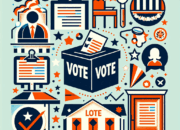Introduction
As we navigate through the electoral landscape of 2025, the importance of election security has surged to the forefront of public concern. With increasing reports of cyber threats, misinformation campaigns, and concerns over ballot integrity, safeguarding the vote has never been more paramount. In this comprehensive exploration of election security, we will delve into the measures, technologies, and policies being implemented to ensure a fair and secure electoral process. By understanding the landscape of election security in 2025, voters can feel more confident about their rights and the integrity of the democratic process.
Understanding the Landscape of Election Security in 2025
Election security in 2025 is shaped significantly by past experiences, particularly the controversies surrounding the elections of 2016 and 2020. These incidents prompted a reevaluation of how elections are conducted, both in terms of physical infrastructure and cybersecurity. Many states have upgraded their voting machines, transitioning from outdated equipment to modern, secure voting systems that utilize advanced encryption methods to protect voter data. These upgrades are crucial as they mitigate risks associated with both foreign interference and domestic hacking attempts.
Moreover, the rise of artificial intelligence (AI) and machine learning has played a pivotal role in enhancing election security measures. In 2025, election officials utilize AI tools to monitor and assess threats in real-time. These technologies can analyze vast amounts of data to detect unusual patterns that may indicate potential security breaches, such as network intrusions or attempts to manipulate voting systems. This proactive approach ensures that election security is not just a reactive measure, but rather a comprehensive strategy aimed at preempting threats.
The Role of Cybersecurity in Protecting Elections
Cybersecurity is at the heart of contemporary election security, particularly as online threats continue to evolve. As more states adopt electronic voting systems and online voter registration, the potential for cyberattacks increases. By 2025, election officials have realized the importance of implementing robust cybersecurity frameworks that focus on protecting sensitive data and maintaining the integrity of election processes. This includes rigorous security audits, penetration testing, and applying cybersecurity best practices across all election-related systems.
In addition to traditional security measures, training and education have become crucial components in safeguarding the electoral process. Election officials and relevant stakeholders are now receiving ongoing training on cybersecurity threats and how to recognize potential fraud. This creates a culture of awareness and preparedness, enabling those involved in the election process to respond efficiently to possible challenges. Furthermore, collaboration with federal agencies, such as the Cybersecurity and Infrastructure Security Agency (CISA), has strengthened the capacity to manage and mitigate cybersecurity threats effectively.
Physical Security Measures for Election Infrastructure
Beyond cyber threats, physical security measures are equally vital when ensuring the integrity of elections. In 2025, many states have taken significant steps to secure polling places, ballot drop-off locations, and election offices from physical tampering or voter intimidation. Enhanced security personnel presence at polling stations, surveillance technology, and secure transportation for ballots are among the measures being implemented.
Election day logistics have also seen improvements. The introduction of secure ballot boxes that utilize advanced locks and tamper-evident seals helps in safeguarding votes until they are officially counted. Additionally, many jurisdictions now employ a paper trail system, where each electronic vote is backed by a physical record, thereby enhancing transparency and accountability in the voting process. These measures ensure that even if electronic systems fail, there is a reliable means to verify the results.
Furthermore, a growing emphasis on public transparency is aiding in reinforcing trust in the electoral system. Election officials are increasingly willing to invite independent observers to monitor the election process, providing additional checks and balances that further strengthen the integrity of elections. Making election data publicly available also plays an essential role in maintaining public confidence in the system.
Mitigating Misinformation and Disinformation
The spread of misinformation and disinformation poses one of the most significant challenges to election security in 2025. Various platforms have become breeding grounds for false narratives, which can distort public perception of the electoral process and undermine voter confidence. To tackle this issue, a multi-faceted approach has been adopted, involving tech companies, government agencies, and non-profit organizations working together to counter misinformation campaigns.
Social media companies have implemented algorithms designed to identify and reduce the visibility of false information about elections. In conjunction with this, fact-checking organizations play a crucial role in debunking falsehoods and clarifying election-related issues for the public. They work to ensure voters have access to accurate and trustworthy information, fostering an environment where informed voting can thrive.
Moreover, educational initiatives that focus on media literacy have gained traction, equipping voters with the tools needed to navigate the complex information landscape effectively. By teaching individuals how to critically assess the sources of information they encounter, these programs empower voters to make informed decisions, ultimately strengthening democracy.
Enhancing Voter Access and Participation
Election security must also encompass efforts to enhance voter access and participation, ensuring that every eligible voter can cast their ballot without facing barriers. In 2025, many states have adopted innovative policies designed to increase accessibility, such as expanded mail-in voting options, early voting periods, and measures to assist individuals with disabilities.
Mail-in voting has become increasingly popular, especially in the wake of the COVID-19 pandemic, as it allows more individuals to participate in the electoral process from the safety of their homes. States have worked diligently to implement secure systems to verify mail-in ballots, using techniques such as signature matching and barcoding, to minimize the risk of fraud while promoting accessibility.
Additionally, outreach programs targeting underrepresented communities have been developed, aimed at educating citizens about their voting rights and available options. Collaborations with community organizations and local leaders create a grassroots effort that helps to demystify the voting process and ensure that everyone knows how to exercise their right to vote.
Conclusion
In conclusion, election security in 2025 is a multi-faceted landscape that combines technological innovation, proactive policymaking, and community engagement. The challenges posed by cybersecurity threats, misinformation, and accessibility barriers are being met with comprehensive approaches designed to safeguard the democratic process. As we move forward, it is crucial that all stakeholders, from government officials to everyday citizens, remain vigilant and invested in the integrity of elections. By working together, we can ensure that the electoral process in 2025 and beyond is fair, transparent, and secure.
FAQs
Why is election security important in 2025?
Election security is essential to protect the integrity of the democratic process, ensuring that every vote is counted accurately and that the results reflect the will of the people.
What measures are being taken to secure elections against cyber threats?
Election officials are adopting advanced cybersecurity frameworks, conducting security audits, and utilizing real-time monitoring technologies to protect election systems against cyber attacks.
How does physical security contribute to election integrity?
Physical security measures, such as securing polling places and ballot drop-off locations, safeguard against tampering and ensure that every vote remains confidential and protected throughout the election process.
What role does misinformation play in election security?
Misinformation can undermine voter confidence and distort perceptions of the electoral process. Counteracting misinformation is essential for maintaining public trust and ensuring informed voting.
How can voters ensure they participate effectively in elections?
Voters can participate effectively by educating themselves about their voting rights, being aware of available voting options, and critically assessing the information they encounter regarding the electoral process.












